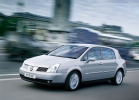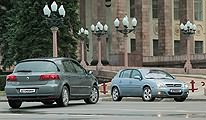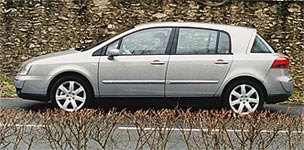Test drive by Renault Vel Satis 2002 - 2005 hatchback
The return of the high sedan
 Renault interprets prestige in its own way
Renault interprets prestige in its own way Vel Satis replaces the Renault Model Safran, known since 1992 on the right flank. The appearance of a serial model at the 2001 Geneva Salon was preceded by a concept car of the same name (Paris, 1998). The front -wheel drive car has the only version of the transformable body - in the terminology of Renault, a high sedan.
The name of these notes was prompted by a film, also French, once popular in Russia.
Creating Vel Satis was much more expensive than a harmless comedy - even a grand blockbuster: 548.7 million euros! (Of these, almost half fell on engineering work and design). Naturally, having invested in large funds, Renault counts on the success of the visa ... - It is to blame, the buyer. It is hoped that these connoisseurs of a special lifestyle, part of which will become Vel Satis, will be gained by 2008 about 300 thousand.
Not just an alloy of comfort, speed, safety, but something original, or even more - a national symbol. It was this goal that the creators of Renault Vel Satis set themselves. To someone, and Renault not to occupy the identity: more than once its models determined the fashion for decades ahead, became a role model; The latest example is the mini -wen Renault stage.
 True, in the representative class (this is the segment of the European market) - its own standards, mainly German origin: Mercedes, BMW, Audi. But following the recognized samples, the creators of Renault Vel Satis considered a mistakenly good idea.
True, in the representative class (this is the segment of the European market) - its own standards, mainly German origin: Mercedes, BMW, Audi. But following the recognized samples, the creators of Renault Vel Satis considered a mistakenly good idea. The first impression of the new Renault is high. It does not deceive: Vel satis for as much as 130 mm is higher than the predecessor of traditional proportions. Tall is not just prominent: it is a natural landing, a good review, an abundance of air. Vel Satis will appreciate people of large physique (provided that their financial situation is to match physical condition ...).
The amenities are determined, of course, not only with a height: the front seats have a wide range of adjustments. There are five of them in total: back and forth, up-down, tilt of the back (separately the upper and lower parts), the height of the front edge of the seat. Three -point belts are built into the backs of the front seats.
Before you choose the most convenient pose and let the engine, you should look around. The interior is kind and quite modern, although the designers did not seek to create an atmosphere of a spaceship in an unusual machine in appearance. Even the navigator display is hidden under an elegant visor along with round arrow instruments of a completely traditional kind. The color scheme is excellent in the decoration of light colors, although not so convincing in dark colors.
The atmosphere of the trip is an important thing and literally. A climate control is responsible for the state of air in the cabin: it is possible for him to individual adjust the conditions for each passenger.
 Isn't it like a monologue of a realtor praised a modern apartment. But we have a car in front of us! Then we start? Just do not bother in search of the ignition lock and, in general, forget the word key. An electronic card with a personal code (we opened the doors by unlocked the alarm) insert into the slot on the panel and press the Start button: Start is given! Once this was followed by the phrase: the salon was filled with a mighty roar of the engine - but no, now, as they say, neither a rustle nor sound. But under the hood - almost 250 horses, the most powerful motor in the gamut of Vel Satis.
Isn't it like a monologue of a realtor praised a modern apartment. But we have a car in front of us! Then we start? Just do not bother in search of the ignition lock and, in general, forget the word key. An electronic card with a personal code (we opened the doors by unlocked the alarm) insert into the slot on the panel and press the Start button: Start is given! Once this was followed by the phrase: the salon was filled with a mighty roar of the engine - but no, now, as they say, neither a rustle nor sound. But under the hood - almost 250 horses, the most powerful motor in the gamut of Vel Satis. Touching, you will not need to let go of the handbrake. The parking brake is automatic here: he will feel that it is time to take the pads. This device is a novelty, but an automatic gearbox for the top version is a long time for machines of this class. And the ability to switch the automatic transmission manually became ordinary. The electronic brain is trained excellently: the box works clearly, gently, does not irritate thoughtfulness. Japanese quality!
Do not be surprised - this is the real result of cooperation between two giant companies, Renault and Nissan. Both V-shaped sixes, gasoline and diesel, like a five-speed machine, are made in Japan. Renault saved on expensive developments and preparation of production, his eastern partners were able to increase the profitability of their products, and the consumer received an original machine with remarkable qualities.
However, then, at the wheel, I was not distracted by thoughts about the advantages of globalization - there were quite enough sensations from controlling a solid, powerful, obedient - and besides a completely new car. I won’t assure that everything is impeccable in it: an aerodynamic noise makes itself felt, sometimes a navigator is alive, and a parking sensors have been excessively delicate, warning about the obstacle when moving in reverse. As for the aerodynamics, I agree with the Renault engineer: the air noise has become more audible because mechanical noises were suppressed from the operation of the units. You can’t call him annoying. And to teach navigation and other electronics - the task is quite feasible. Everything that makes the car in the classical sense is fulfilled soundly and meets the standards accepted in the classroom.
 Of the features of behavior on the road, I note noticeable rolls in corners and sailing, especially tangible when traveling with trailers. Both are the fee for external solidity and space in the cabin: the center of the masses is raised, and the sidewall area is large in comparison with lower bodies.
Of the features of behavior on the road, I note noticeable rolls in corners and sailing, especially tangible when traveling with trailers. Both are the fee for external solidity and space in the cabin: the center of the masses is raised, and the sidewall area is large in comparison with lower bodies. At the wheel of Satis, you do not get tired of either in the city (excellent visibility helps here), not on the highway - the brake dynamics of the machine to match the acceleration. The above is equally true for both modifications tested on a test drive - with gasoline and diesel six. Moreover, according to the subjective impression (what else can the presentation give?) The second option is even more comfortable.
As for other engines, you will draw a minimum of information about them from the table. I will add that all the diesel engines are with direct injection by a Ural Rail, and a 2 -liter gasoline engine with a turbocharged - a novelty in the company's program.
 The word novelty is the key to describe the stage model Renault. Whether it is a multi-link rear suspension of a trigon (that is, a triangle), control in tire pressure, a cruise control with a distance sensor, ugly wiper brushes moving towards each other (their move is somewhat reminiscent of a dimpled surge with hands), a DVD player. However, it is calmer to watch a movie at home, especially when I am sure that your car is under reliable guard. The key to this is the features of the proprietary anti -theft. For example, a castle with an electronic code blocks the steering wheel in any position, in addition, it is able to dissolve control, so trying to tear the steering wheel simply pointless. But even before attempts to open the car are opposed by specially reinforced doors and trunk lid.
The word novelty is the key to describe the stage model Renault. Whether it is a multi-link rear suspension of a trigon (that is, a triangle), control in tire pressure, a cruise control with a distance sensor, ugly wiper brushes moving towards each other (their move is somewhat reminiscent of a dimpled surge with hands), a DVD player. However, it is calmer to watch a movie at home, especially when I am sure that your car is under reliable guard. The key to this is the features of the proprietary anti -theft. For example, a castle with an electronic code blocks the steering wheel in any position, in addition, it is able to dissolve control, so trying to tear the steering wheel simply pointless. But even before attempts to open the car are opposed by specially reinforced doors and trunk lid. By the way, the side doors and the hood for the sake of relief are made of aluminum - maybe not a novelty, but the solution is still rare on mass machines. I avoid expression on the fifth door, since Renault presented the car like a sedan - so, the trunk lid is made of heat -adapted plastic, like the front wings. General winning mass compared to steel - 80 kg!
Another figure deserves attention: 90% of the materials from which the parts of Satis are made are suitable for processing and re -use. Saving resources is a sign theme of the modern world, some results here simply amaze. For example, the spark plugs will last 120 thousand km, the same is the belts of camshafts. Even an air filter on a gasoline six will be replaced after 60 thousand (I wonder what amendment will be introduced to Russian conditions?).
But not only on the service and consumables will save the owner of the new Renault: also - on body repair and insurance. With small (parking) accidents, when the speed does not exceed 15 km/h, the radiator cladding, the wings and the interior enrolls retain the shape. This should be impressed by the owner of a prestigious car: in such a machine a neat appearance is especially appreciated.
I return to what I started - to the appearance, the features of the perception of an unusual form. The creators of Vel Satis refer, in particular, to the fact that traditional sedans in class e gradually lose their positions. Their credo: as if again inventing a high sedan. They trust in the authority of French culture, which has always been distinguished by an innovative approach to public objects: recall the Parisian center Pompidu or a glass pyramid in the Louvre. Whether these considerations will affect the buyer (of course, coupled with the advantages of the car itself), we will soon find out. In Europe, Vel Satis is sold from March at a price of 30 to 47 thousand euros; In Russia, it should appear in the fall.
Text / Vladimir Arkush
Photo / Vladimir Arkusha, Renault
Source: The magazine "Driving"
Video Crash tests Renault Vel Satis 2002 - 2005
Test drives Renault Vel Satis 2002 - 2005
Renault Vel Satis 2002 - 2005 crash test
Krassh Test: Detailed Information33%
Driver and passengers
2%
Pedestrians











